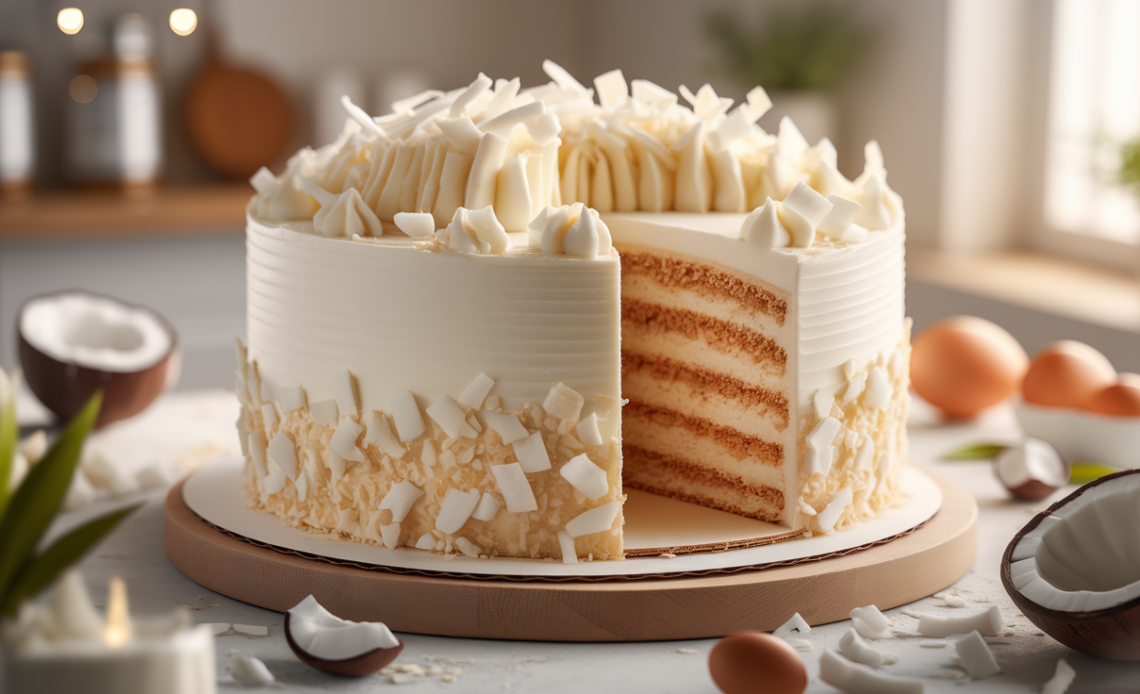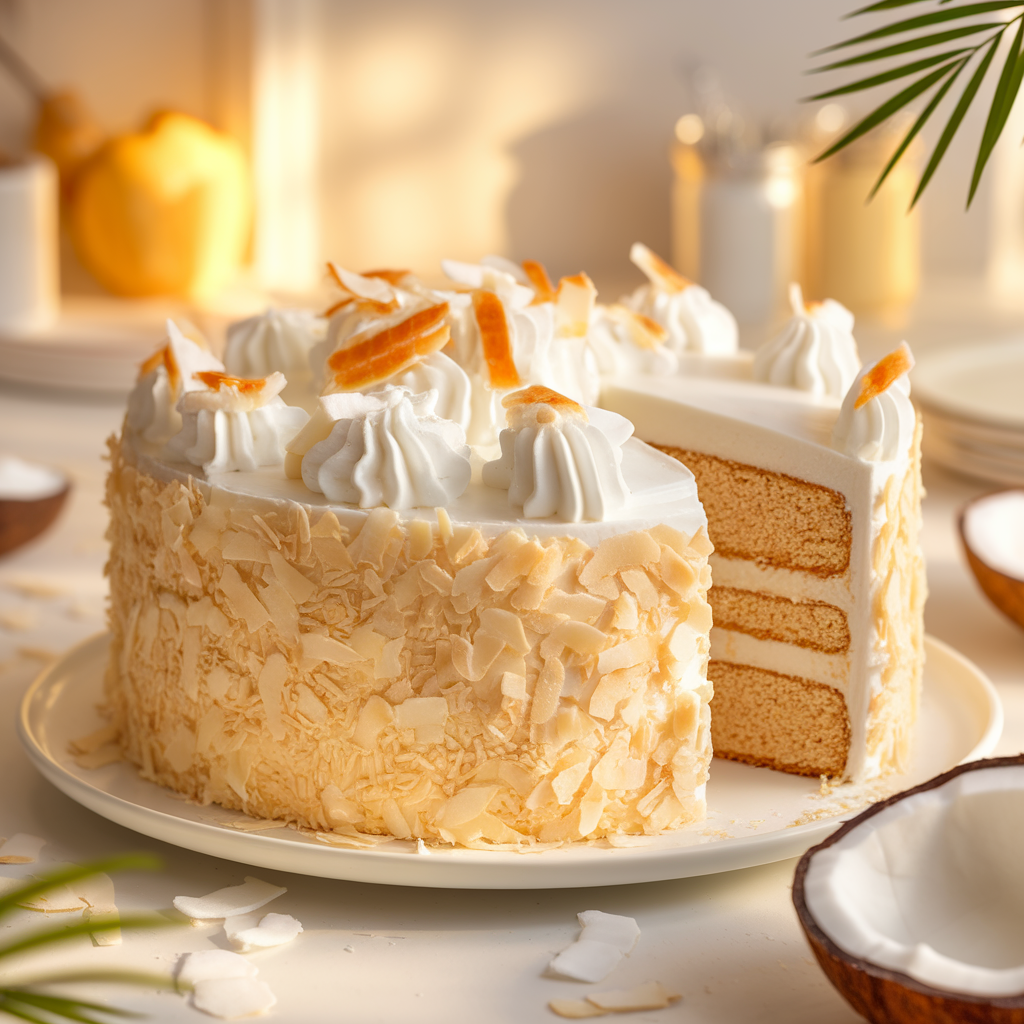
There’s something timeless and indulgent about a beautifully made coconut cake. Soft, fluffy, and fragrant, a well-crafted coconut sponge cake recipe offers a taste of the tropics in every bite. Whether you’re celebrating a special occasion or simply looking to elevate your dessert game, coconut cake is a decadent treat that’s surprisingly simple to make with the right ingredients.
In this comprehensive guide, we’ll show you how to make coconut cake that’s moist, flavorful, and infused with coconut in every layer. From using coconut cream in recipes to incorporating coconut milk, and even decorating with fresh coconut, this article will help you master the art of the perfect cake with coconut.
The Allure of Coconut in Baking
Coconut has long been cherished for its rich, creamy flavor and versatility in both savory and sweet dishes. In baking, coconut adds a unique depth and aroma that is hard to match with any other ingredient. The combination of coconut cream, coconut milk, shredded coconut, and coconut extract can turn a simple dessert into an exotic, flavor-packed delight.
Using coconut cream in recipes brings richness and moisture, making it an ideal ingredient in cakes, especially when you want that luxurious tropical mouthfeel. Whether you’re aiming for a light coconut cake or a more indulgent layered dessert, coconut has your back.
Why You Should Try Coconut Cake
If you’ve never tried cake coconut before, prepare to be amazed. Coconut cake isn’t just about a sweet flavor—it’s about texture, aroma, and visual appeal. Whether you opt for a delicate light coconut cake or a richer, denser version with frosting, coconut cake always makes an impression.
Not only is coconut cake a crowd-pleaser, but it also pairs beautifully with a range of frostings and fillings. Think coconut cream cheese frosting or a coconut milk glaze—there are endless ways to customize and elevate this classic dessert.

Ingredients You’ll Need for the Best Coconut Cake
The secret to a delicious coconut cake with coconut milk and coconut cream lies in quality ingredients. Here’s what you’ll need for the perfect coconut sponge cake recipe:
For the Cake:
- 2 ½ cups all-purpose flour
- 1 tbsp baking powder
- ½ tsp salt
- 1 cup unsalted butter, room temperature
- 1 ¾ cups granulated sugar
- 4 large eggs, room temperature
- 1 tsp pure vanilla extract
- 1 tsp coconut extract (for a stronger flavor)
- 1 cup coconut milk
- ½ cup coconut cream
- 1 cup shredded sweetened fresh coconut (optional but highly recommended)
For the Frosting:
- 8 oz cream cheese, softened
- ½ cup unsalted butter, softened
- 3–4 cups powdered sugar
- 1 tsp coconut extract
- ¼ cup coconut cream
- 1–2 cups shredded or flaked fresh coconut for topping
How to Make Coconut Cake: Step-by-Step Instructions
- Preheat and Prepare
Start by preheating your oven to 350°F (175°C). Grease and flour two 9-inch round cake pans. For best results, line the bottoms with parchment paper for easy removal. - Mix Dry Ingredients
In a large bowl, whisk together the flour, baking powder, and salt. Set aside. - Cream Butter and Sugar
In a mixing bowl, beat the butter and sugar together until light and fluffy—this usually takes 3–5 minutes. This step is crucial for achieving a light coconut cake texture. - Add Eggs and Extracts
Add the eggs one at a time, beating well after each addition. Then add vanilla and coconut extract for that signature tropical aroma. - Alternate Wet and Dry
Begin adding the flour mixture and the combined coconut milk and coconut cream, alternating between the two. Start and end with the dry ingredients. Mix until just combined—overmixing can make the cake dense. - Fold in Coconut
If you’re using shredded fresh coconut, gently fold it into the batter. This adds both texture and flavor to the cake. - Bake
Divide the batter evenly between the prepared pans and bake for 25–30 minutes or until a toothpick inserted in the center comes out clean. Let the cakes cool in the pans for 10 minutes before transferring to wire racks to cool completely.

Coconut Cream Cheese Frosting: A Match Made in Heaven
No coconut cake is complete without a rich, velvety frosting. This coconut cream cheese frosting brings tanginess and decadence, perfectly balancing the sweetness of the cake.
Instructions:
- Beat cream cheese and butter until smooth.
- Add coconut extract and coconut cream, and mix well.
- Gradually add powdered sugar until you reach your desired consistency.
- Spread a generous layer between the cooled cake layers, then frost the top and sides.
- Sprinkle with shredded fresh coconut to finish.
Coconut Cake Variations to Try
While the classic version is delightful, coconut cake is incredibly versatile. Here are a few exciting variations:
Coconut Cake with Fresh Coconut and Pineapple
Add crushed pineapple between layers and top with a pineapple glaze for a tropical twist. It’s like eating a piña colada in cake form!
Chocolate Coconut Cake
Add cocoa powder to the batter and drizzle melted chocolate over the frosting. The chocolate enhances the nuttiness of the coconut beautifully.
Coconut Cake with Coconut Milk Only
If you don’t have coconut cream, you can make a version using just coconut milk. It’ll be slightly lighter but still rich in flavor.
Vegan Coconut Cake
Swap eggs for flax eggs and use vegan butter, coconut cream, and plant-based cream cheese for a dairy-free delight.
Tips for the Perfect Light Coconut Cake
- Don’t overmix: Once your flour is added, mix gently to avoid developing too much gluten, which can make the cake tough.
- Room temperature ingredients: This ensures a smoother batter and even baking.
- Use full-fat coconut milk and cream: For best flavor and moisture, avoid low-fat versions.
- Toast some coconut: For added depth, toast some coconut to use as a garnish or mix it into the frosting.
- Chill before slicing: Let the cake set in the fridge for 30–60 minutes before slicing for cleaner cuts.
Decorating Ideas for a Stunning Coconut Cake
Presentation matters, especially if you’re baking for guests or an event. Here are a few ways to make your coconut cake with fresh coconut look as good as it tastes:
- Cover the entire frosted cake in large coconut flakes for a snowball effect.
- Top with edible flowers and thin lime slices for a tropical aesthetic.
- Use a piping bag to add rosettes or swirls of coconut cream cheese frosting.
- Layer the cake with fresh mango or passionfruit slices for added color and flavor.

Nutritional Benefits of Coconut
While this cake is a dessert, coconut itself offers several health benefits:
- Healthy fats: Coconut is rich in medium-chain triglycerides (MCTs), which may aid metabolism.
- Fiber: Fresh coconut adds dietary fiber.
- Antioxidants: Coconut contains polyphenols that can help reduce inflammation.
So while we won’t claim coconut cake is a health food, using real coconut ingredients brings more to the table than just sweetness.
Storing and Serving Coconut Cake
Coconut cake stores well and often tastes even better the next day as the flavors meld.
Storage Tips:
- Keep refrigerated in an airtight container for up to 5 days.
- You can freeze slices for up to 2 months—just wrap them tightly in plastic wrap and foil.
Serving Suggestions:
- Serve with a scoop of coconut ice cream or mango sorbet.
- Enjoy a slice with afternoon tea or a fresh espresso.
Frequently Asked Questions
Can I use canned coconut cream in the cake?
Absolutely. Using coconut cream in recipes like cake adds a dense richness and deep coconut flavor. Just make sure to stir it well before using.
What’s the difference between coconut milk and coconut cream?
Coconut cream is thicker and richer than coconut milk. The former is great for frostings and adding creaminess, while the latter is better for thinning batters and enhancing moisture.
Can I make this as a sheet cake?
Yes! This recipe can be poured into a 9×13-inch pan and baked for about 35–40 minutes.
How do I prepare fresh coconut for the cake?
Crack open the coconut, remove the meat, and shred it using a grater or food processor. Fresh coconut can also be toasted for extra flavor.
Final Thoughts: The Perfect Coconut Cake is Within Reach
Now that you know how to make coconut cake from scratch, you can impress your family and friends with this tropical masterpiece. With the perfect balance of coconut milk, coconut cream, and fresh coconut, this cake is soft, aromatic, and rich with natural sweetness.
Whether you’re creating a light coconut cake for a summer brunch or a luscious layered cake with coconut cream cheese frosting for a birthday celebration, this versatile dessert is bound to become a staple in your recipe collection.
So next time you’re thinking of baking something special, turn to this coconut sponge cake recipe and discover the joy of a cake that’s both comforting and extraordinary.






